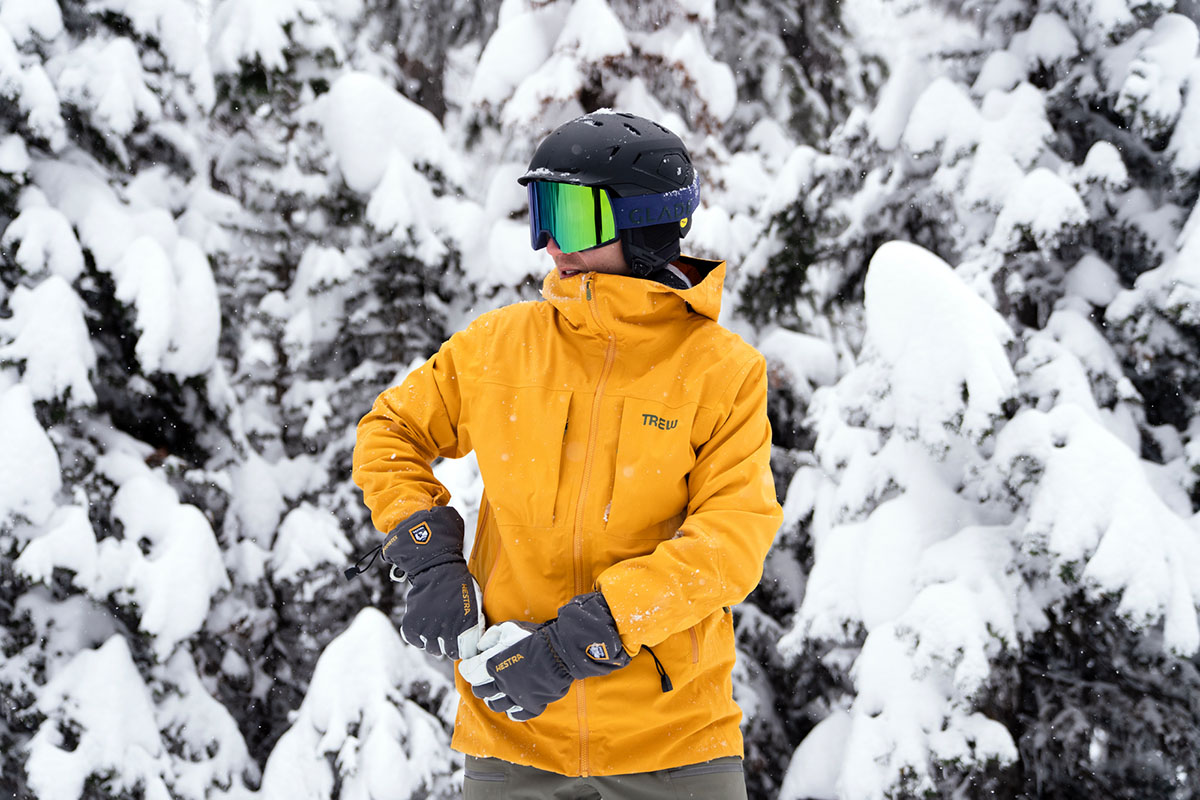
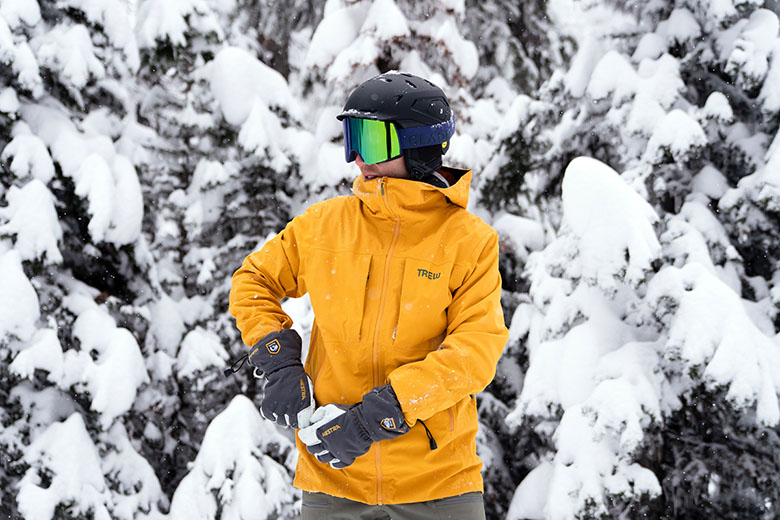
Price: $499
Weight: 1 lb. 11.6 oz. (size small)
Waterproofing: 3L PNW Primo
What we like: Tough and protective yet very comfortable; feature-rich with lots of storage.
What we don’t: Relatively heavy and not a standout breather for dedicated backcountry use.
See the Men's Cosmic Primo Jacket See the Women's Stella Primo Jacket
Trew Gear is a brand on the rise, and their longstanding, core men’s ski shell is the Cosmic. Balancing weather protection, mobility, and features for resort and backcountry days, it’s a versatile piece with wide appeal. And the latest Primo version ups the ante in sustainability with a recycled shell and bluesign certification. We put the Cosmic Primo through nearly a full season of use and found it to be extremely well made with generous storage, excellent weatherproofing, and high levels of comfort thanks to the stretchy build. It’s not a go-to backcountry option given its less breathable construction, but the rest of the design truly impressed. Read on for our full impression of the jacket. To see how it stacks up to the competition, check out our articles on the best ski jackets and best snowboard jackets.
Editor’s note: We tested the 2023 version of the Cosmic Primo Jacket for this review. Trew Gear lightly updated the design in early 2024 to include more adjustments to cinch down the hood, a revised hood shape, a new interior zippered chest pocket, and additional articulation in the sleeves.
Trew Gear keeps their waterproofing designs in-house, but we’ve found the levels of quality and protection line up with proven alternatives like Gore-Tex. The Cosmic Primo Jacket utilizes the brand’s 3-layer PNW Primo membrane, a burly shell fabric coated with a durable water repellent (DWR) finish, and fully taped seams. The combination proved to be a standout performer throughout a variable and very snow-heavy winter in the Pacific Northwest. I experienced zero waterproofing failures or notable issues despite a wide range of conditions—from freezing rain and blowing sleet to deep powder days. Combined with a very similar experience with the women’s Stella Primo Jacket, we can confidently say that overall weather protection is a hallmark of the Primo design.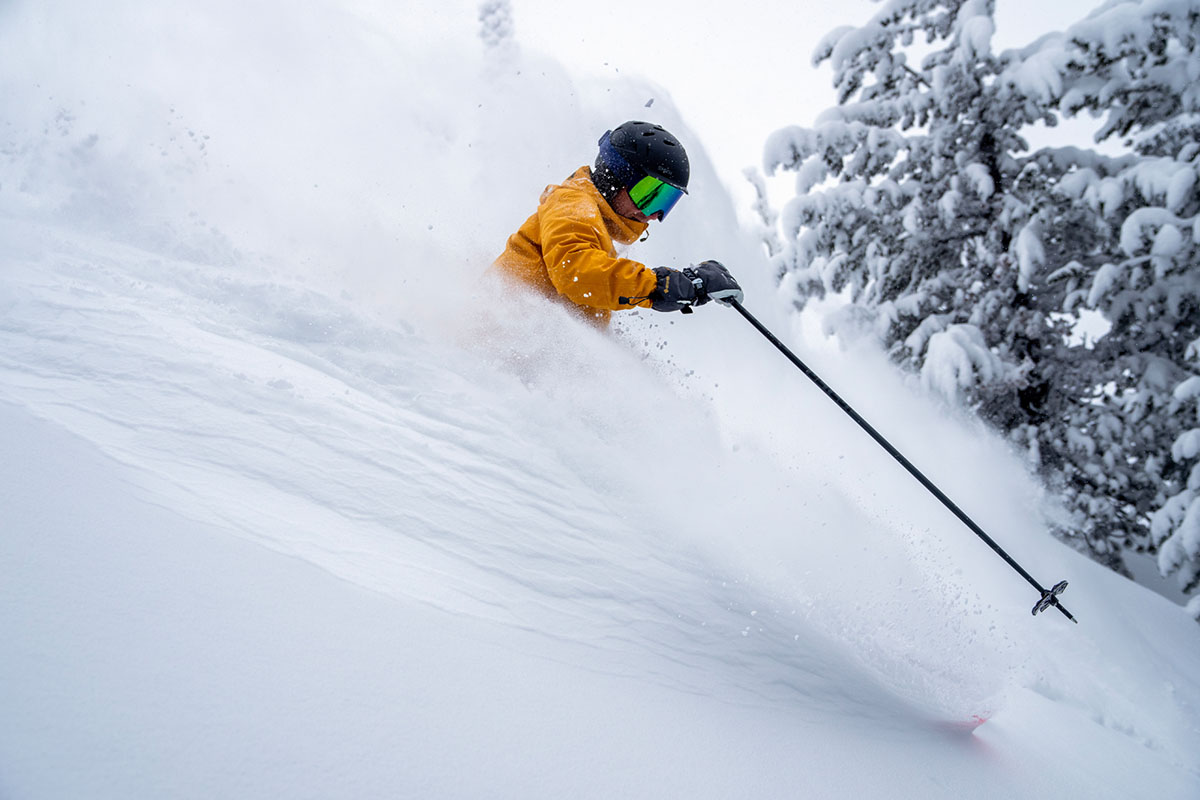
Some crossover resort and touring jackets trade windproofing for a bump in breathability and can run colder and draftier as a result, but it’s clear Trew Gear favored maximum protection here. The thick shell gives the Cosmic a fortress-like feel in heavy gusts, and we think they nailed most of the details, including an extended cut for extra coverage; a tall collar that reaches over my top lip; a powder skirt and ski helmet-compatible hood; and coated, water-resistant zippers on all exposed pockets (as well as the pit zips). 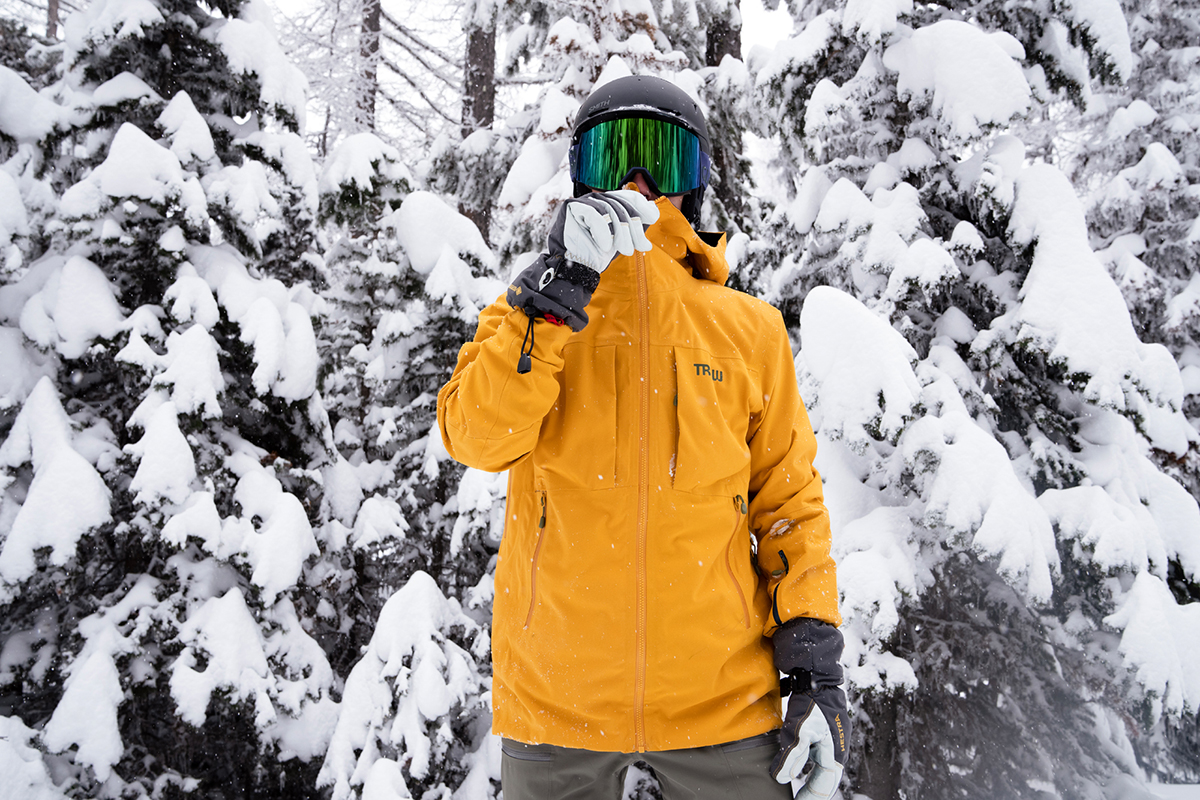
On the cuffs, Trew utilized oversized Velcro straps that fit comfortably over my undercuff ski gloves and sealed out weather effectively. The large straps did prove to be awkward when cinching them tight under a gauntlet-style glove, however. I found there was a lot of extra fabric that folded over when pulling the cuff snug, particularly at the left forearm that has the lift pass pocket. It’s worth noting that Trew Gear did redesign the articulation of the sleeves for the 2024 version, and we’ll report back here if the new shaping resolved this small complaint.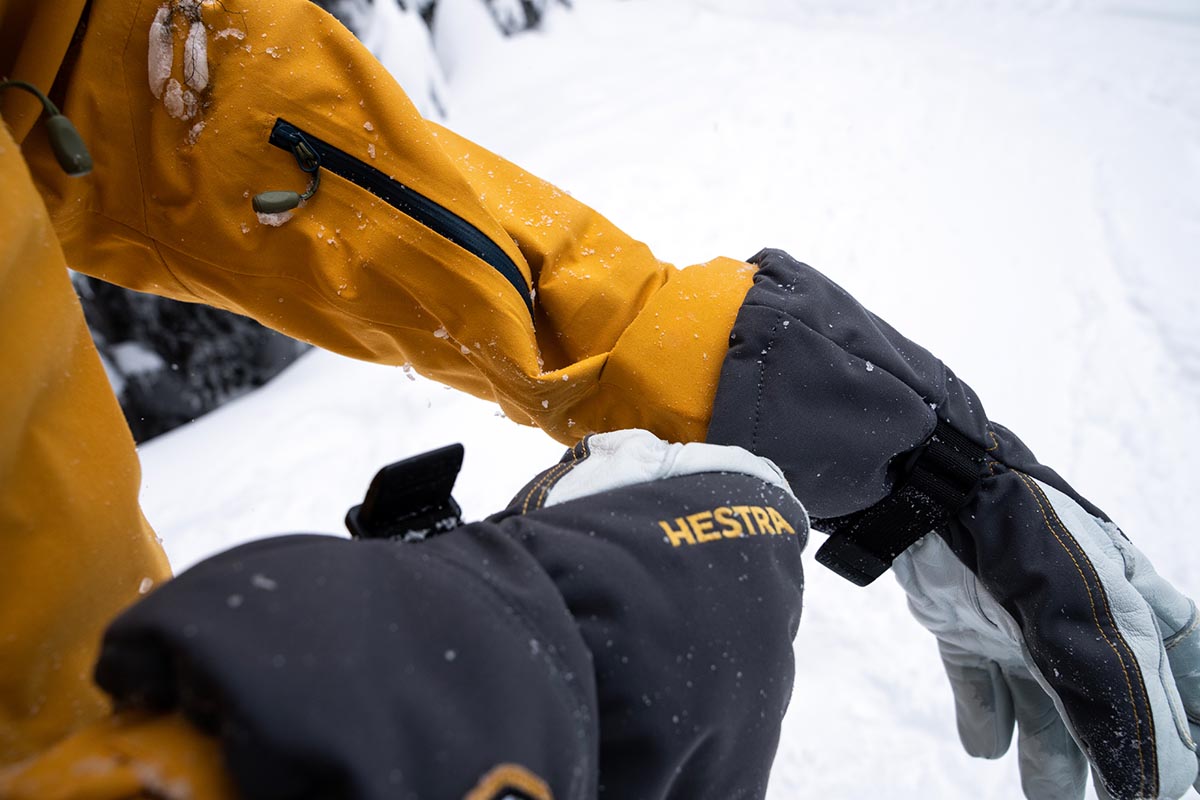
As we touched on above, it’s clear protection was a priority, and we found the Cosmic Jacket’s breathability did suffer as a result. Compared with a lighter and thinner backcountry design like Outdoor Research’s Skytour, the Cosmic’s thicker build was faster to heat up during a sidecountry hike or while skinning in snowy conditions (otherwise I would’ve removed the jacket completely). It’s certainly not a dealbreaker, and utilizing the large pit zips did help considerably with regulating my temperature. In the end, the balance lined up with my general impression of the Cosmic’s best use: for active resort skiers and those who only head into the backcountry a few times a year. However, if you put a premium on air permeability and outright comfort on the skin track, there are certainly more breathable options on the market.
With an almost softshell-like feel—complete with built-in stretch—the Cosmic offers exceptional comfort. The jacket is built with a relaxed cut (more on this in “Fit and Sizing” below), and I opted to size down after consulting the sizing chart. The resulting athletic fit combined with the stretchy build was a boon for active use: There was plenty of space for layering, and the extra give in the fabric never led to any binding or discomfort even while hauling skis, transitioning, or reaching down to access gear in my pack. It was the kind of just-right feel that fades quickly to the background while skiing—exactly what you want out of a ski shell. And the relatively soft and smooth interior (for a waterproof jacket) meant it was perfectly fine pairing with a t-shirt in warm conditions.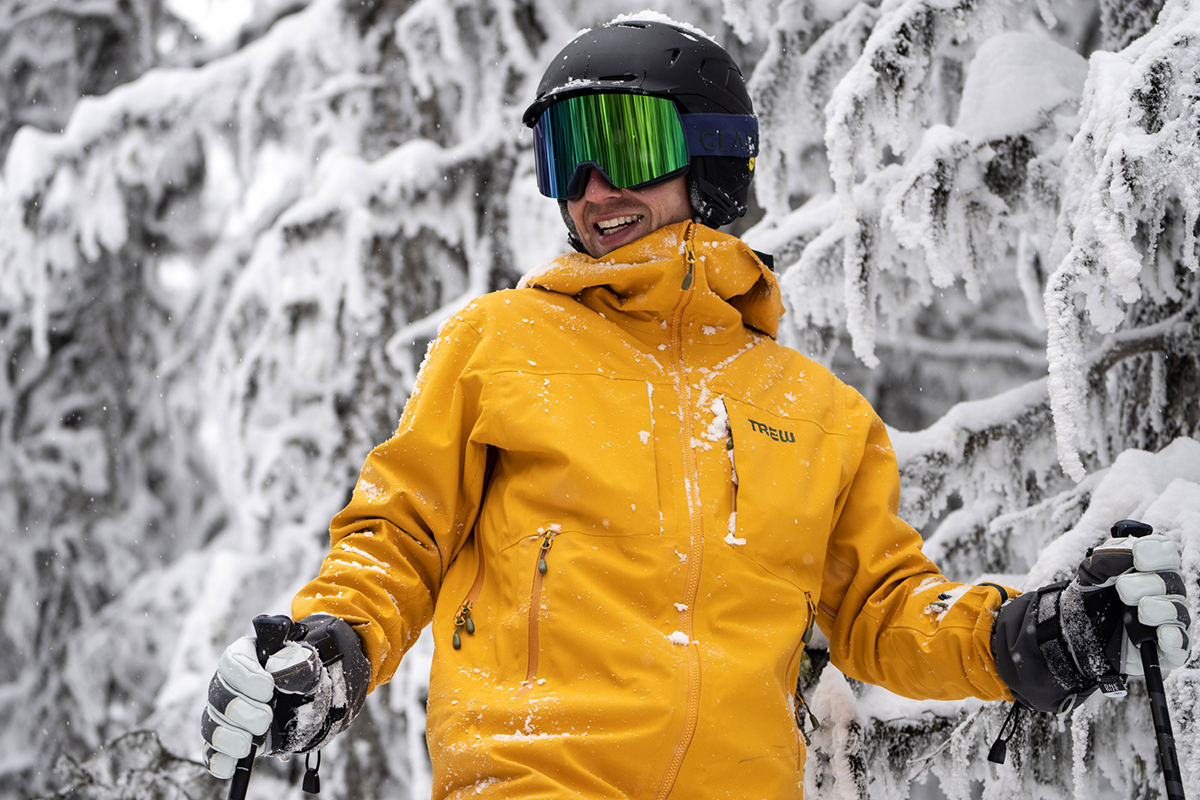
My first impression of the Cosmic Primo was very positive: The shell fabric had a solid and high-end feel, the interior was comfortable, and all the smaller details jumped out as premium. The main center zip has large teeth and operates very smoothly, there are easy-to-operate pull tabs on all exterior zippers, and the cords for the waist and hood adjustments are thick and clearly high-quality. Ski jackets are a pricey breed in general, but the Cosmic’s construction manages to exceed its $499 listed price, in my opinion. And just as importantly, everything has held up and still functions like new after 30-plus days of hard use. In fact, a close inspection revealed essentially zero signs of wear. And staying on top of the washing process—I’ve put it through wash and dry cycles a few times thus far—has helped keep the DWR coating functioning properly. 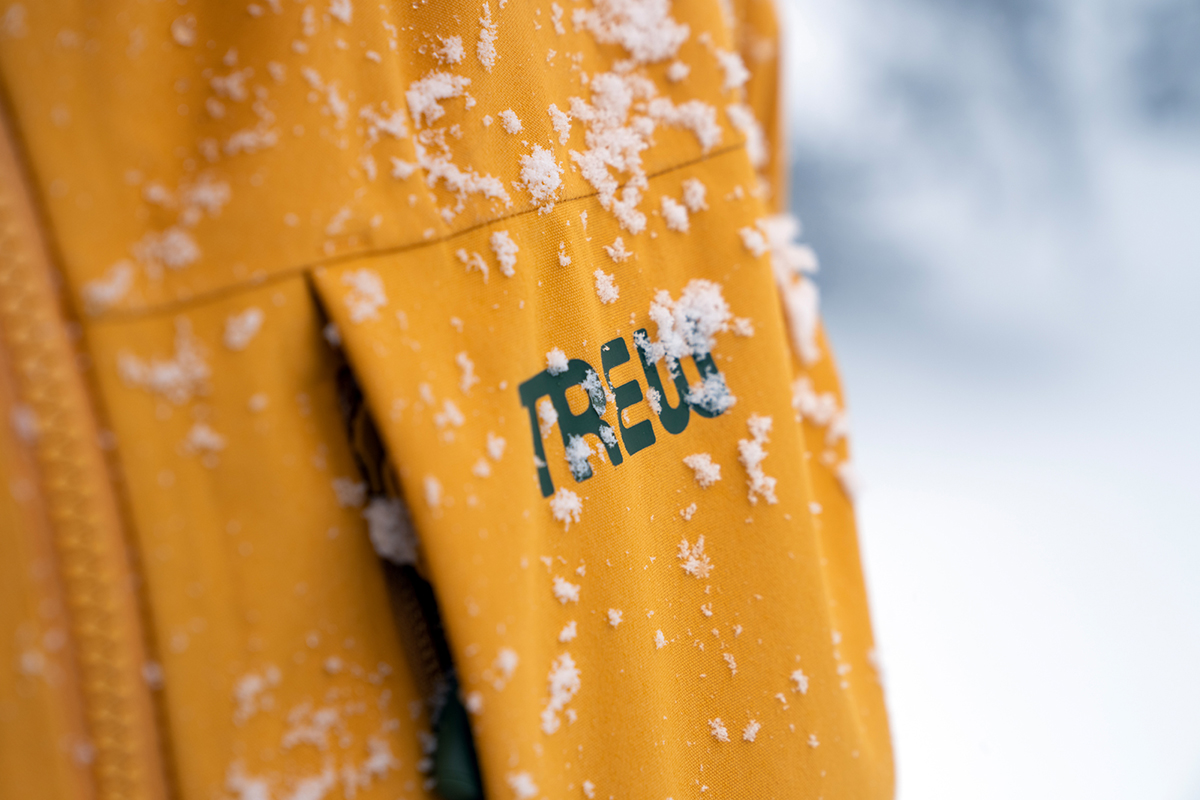
The Cosmic’s feature-rich and durable construction does add some weight, and my men’s size small ended up at 1 pound 11.6 ounces on my scale (Trew lists the latest version at 1 lb. 14.1 oz. for a size medium). This puts it decidedly on the heavier end of the spectrum among crossover touring shells. For comparison, Arc’teryx’s premium Sabre Jacket (1 lb. 8.9 oz.) and Outdoor Research’s Skytour (1 lb. 6.1 oz.) and Carbide (1 lb. 5.5 oz.) all undercut the Cosmic. A closer comparison is Black Diamond’s Recon Stretch, which shares a similar overall build for 1 pound 11 ounces.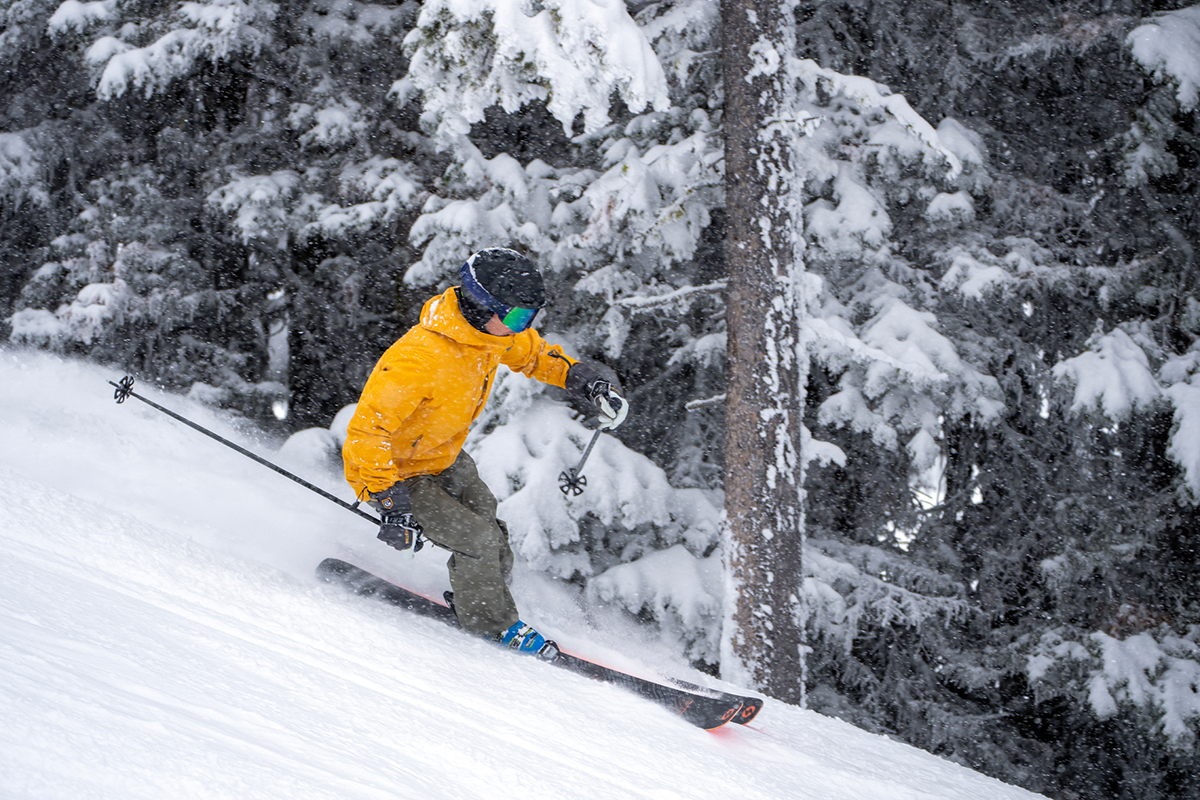
It’s a similar story with the jacket’s packability: Rolled into its hood, the Cosmic Primo Jacket is roughly the size of an American football. You can certainly throw it in a touring pack—and removing the powder skirt will help trim off a little weight (2.2 oz.) and reduce the packed size if you’re really counting grams—but it’s undeniably on the bulkier end. Combined with the thicker and less breathable construction, the Cosmic simply isn’t a backcountry leader.
Trew Gear gave the Cosmic’s hood design a rethink for the 2024 version, so my impressions of the old setup aren’t entirely applicable. The main change is that it’s now adjustable in three places—there’s one drawcord at the back of the head and two flanking the front (the old model only adjusted at the back). Additionally, Trew calls out in their product description that it’s intended to be more helmet-friendly. Coming from the prior-generation model, I think this is a positive change, as my hood was a snug fit—albeit manageable—when worn over my size medium Smith Nexus helmet. We’re looking forward to trying out the latest Cosmic to see if the updates make it more accommodating for bulky lids. And a final note: Trew Gear retained the Recco reflector found on the past-season model, which is hidden in the hood’s brim and adds a nice dose of security in the event of a rescue.
As I touched on above, the Cosmic Primo is an unapologetically feature-rich design, and the eight-pocket storage layout is an obvious reflection of that focus. Starting at the outside, you get two generously sized hand pockets, dual chest pockets that can accommodate a large smartphone or snacks for the day, and a ski pass pocket on the left forearm. The left chest pocket also boasts an inner mesh sleeve for keeping your phone separate, as well as a port through which you can route headphone cords. The interior storage layout comprises two mesh dump pockets that are great for stashing items like climbing skins, gloves, or a beanie, as well as a small zippered chest pocket on the right side (note: The final pocket is new to the 2024 version).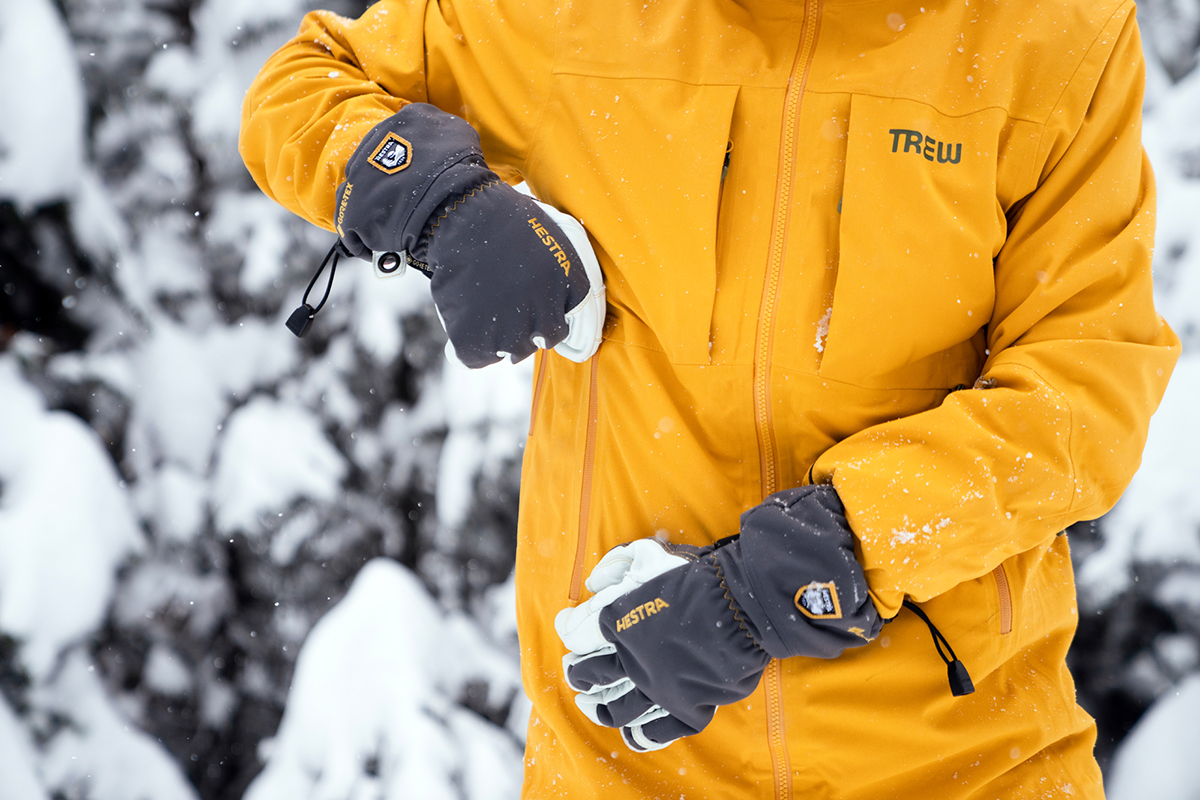
Like most modern ski jackets, the Cosmic Primo includes a powder skirt for sealing out moisture when skiing deep powder or in the event of a fall. The design uses grippy elastic around the perimeter to keep it in place, with snaps at the front to secure it shut. Trew Gear didn’t design the skirt to attach to compatible ski pants (many premium competitors do offer that ability), but the good news is that it’s removable when conditions are favorable or you want to shave a couple ounces. All in all, it’s a functional design and a nice extra line of defense.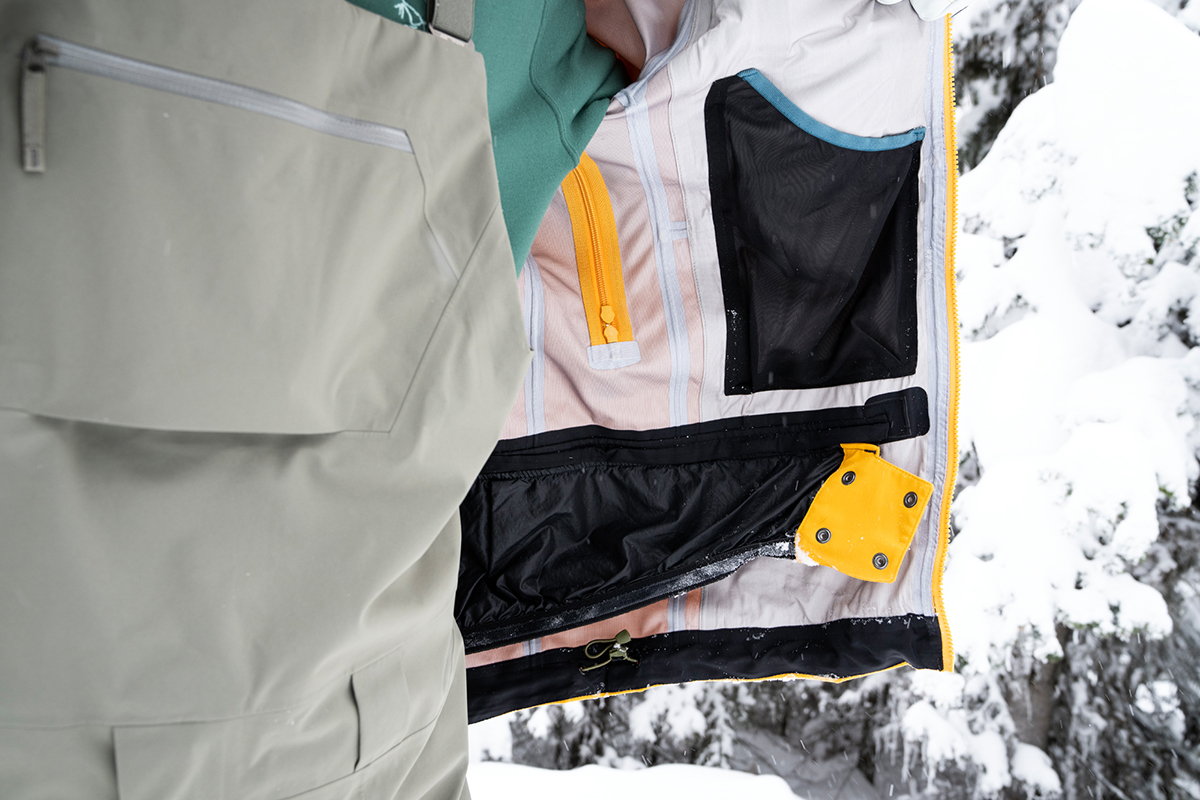
The Cosmic Primo is listed as having a “relaxed style,” and I found the level of detail on Trew’s product page—complete with sizing info about the various models—extremely helpful. After consulting the chart, I opted to size down from my standard men’s medium to a small (for reference, I’m 5’9”, weigh 155 lb., and have a 38-in. chest). This proved to be as good of a fit as I’ve ever had with a ski shell: I had room to vary my base- and midlayers from a thin long-sleeve merino shirt up to a midweight synthetic jacket without any excess bulk, discomfort, or binding, and the athletic cut was excellent for active uses like hiking and skinning. Additionally, the sleeve length was spot-on for me, and sizing down didn’t compromise on back length or overall coverage. Finally, it’s worth noting that the latest version of the Cosmic Primo is available in extended sizes up to 5XL, which come in three attractive colorways.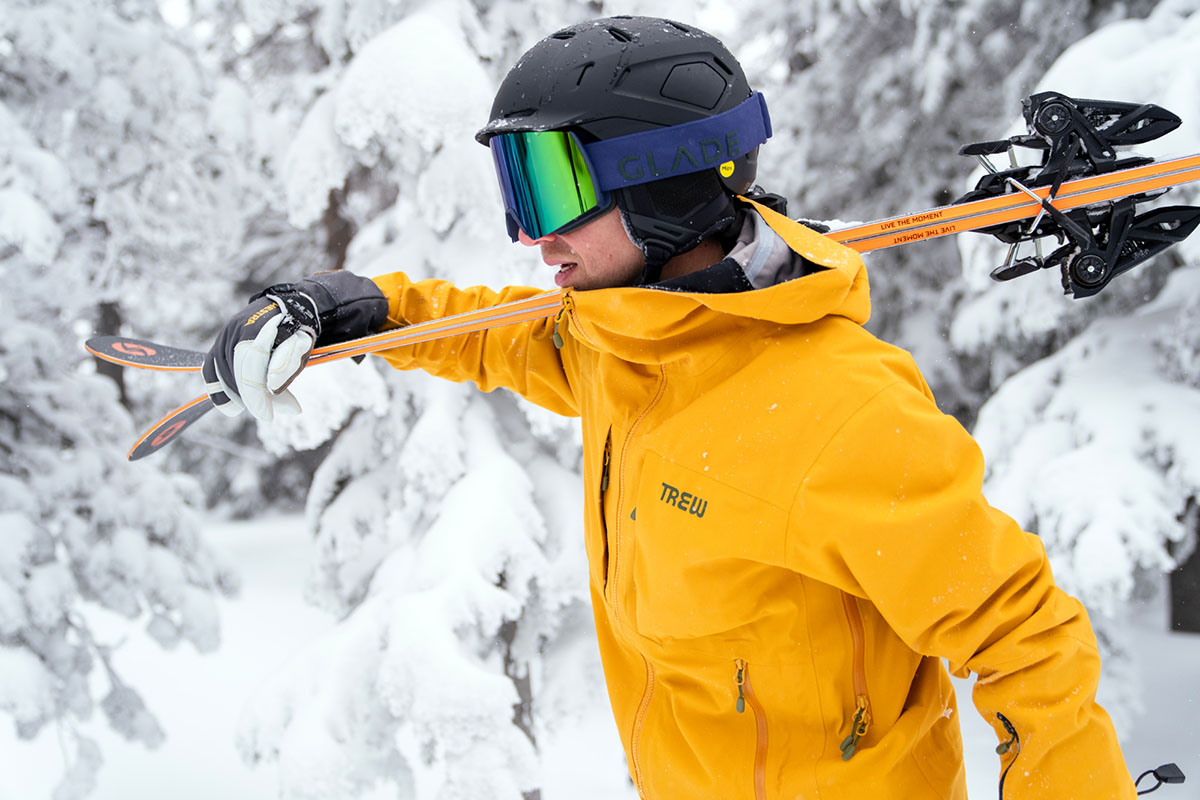
One way that brands are staying competitive is by incorporating more sustainable practices into production, and Trew Gear is no exception. In this case, the Cosmic Primo Jacket utilizes a 100%-recycled nylon shell that’s bluesign-certified, which means it’s made without the use of harmful chemicals and has been deemed safe for workers, consumers, and the environment. We’d love to see a PFAS-free DWR coating and/or certification to the Fair Trade standard in a future update, but we nevertheless appreciate the brand’s efforts thus far.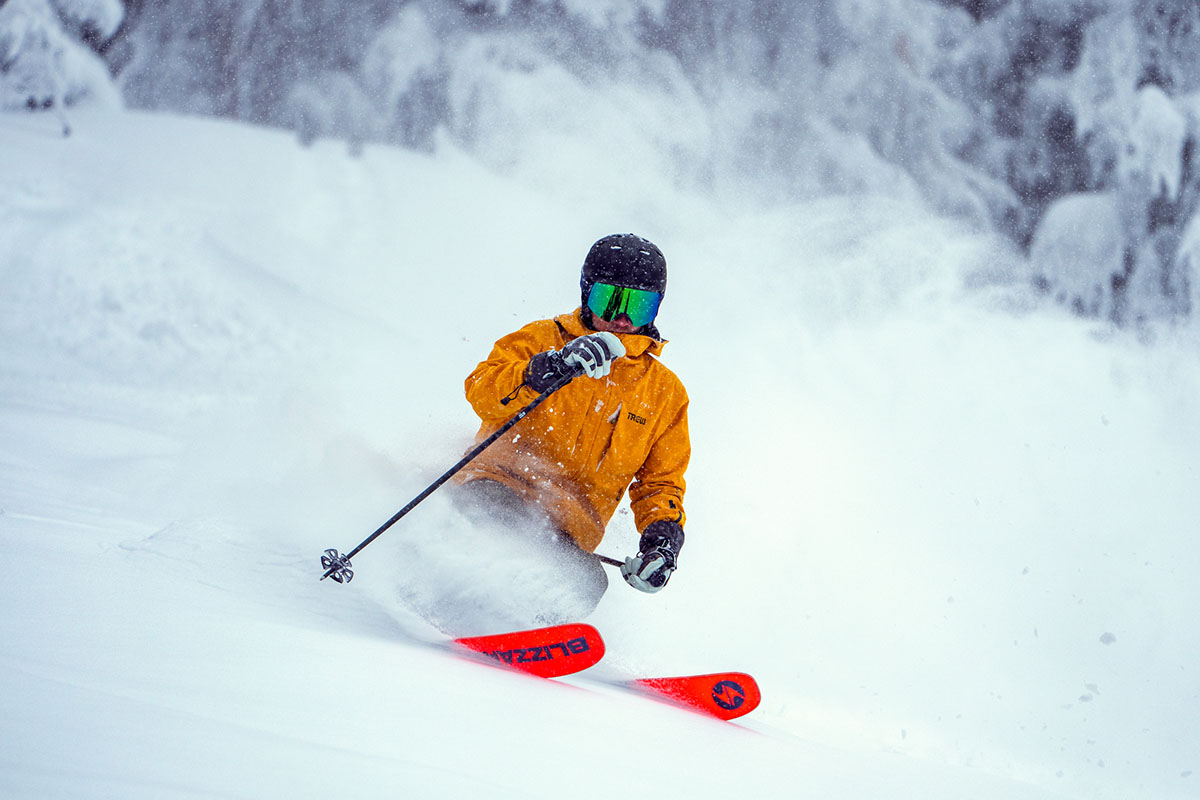
I tested the men’s Cosmic Primo Jacket for this review, and the women’s counterpart is the Stella. Stacked up against the men’s model, the women’s Stella Primo Jacket costs the same at $499 and retains a largely identical overall build but weighs a little less (1 lb. 13.5 oz.) and comes in different colorways. Like the Cosmic, the Stella is also available in a healthy range of sizes (from XS to 4X) and a nice variety of colorways (for more, see our in-depth Stella Primo Jacket review). The latest collection ends there, although the past-generation Cosmic Primo, Stella Primo, and “Classic” versions of both jackets—which are a small step down in waterproofing and durability—are all heavily discounted while supplies last.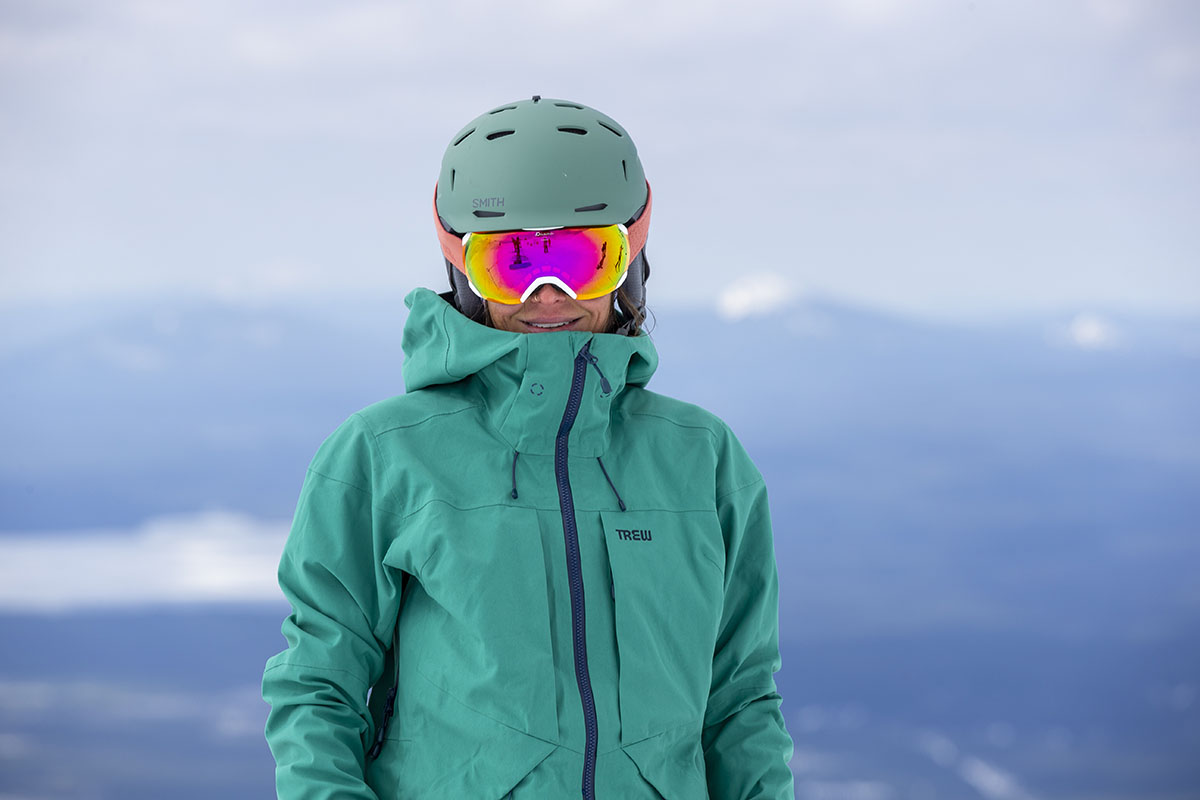
| Jacket | Price | Best For | Waterproof | Weight | Pockets | Recco |
|---|---|---|---|---|---|---|
| Trew Gear Cosmic Primo Jacket | $499 | Resort | 3L PNW Primo | 1 lb. 14.1 oz. | 8 | Yes |
| Flylow Gear Malone Jacket | $400 | Backcountry/resort | 3L Tactic | 1 lb. 8 oz. | 5 | No |
| Outdoor Research Skytour | $399 | Backcountry | 3L AscentShell | 1 lb. 6.1 oz. | 6 | No |
| Outdoor Research Carbide | $329 | Backcountry/resort | 3L Pertex | 1 lb. 5.5 oz. | 7 | No |
| Arc'teryx Sabre Jacket | $750 | Resort/backcountry | 3L Gore-Tex | 1 lb. 8.9 oz. | 6 | Yes |
| Patagonia Storm Shift Jacket | $499 | Resort | 2L Gore-Tex | 1 lb. 12.8 oz. | 6 | Yes |
The Cosmic Primo Jacket is a tough, protective, and feature-rich resort ski jacket, but backcountry riders won’t love the heft and lack of breathability. For around 6 ounces and $100 less, the Flylow Gear Malone Jacket offers similar appeal at a lower weight and price point. In this case, Flylow opted for a smooth and stretchy 3-layer construction that has the comfort and breathability of a softshell. However, weatherproofing is a notable concession—the Malone lacks the fortress-like feel you get with the Trew Gear—and the Flylow is more limited on storage with just five total pockets. It also can’t match the toughness and overall build quality of the Cosmic, which is enough for us to recommend the Trew Gear over the Flylow. 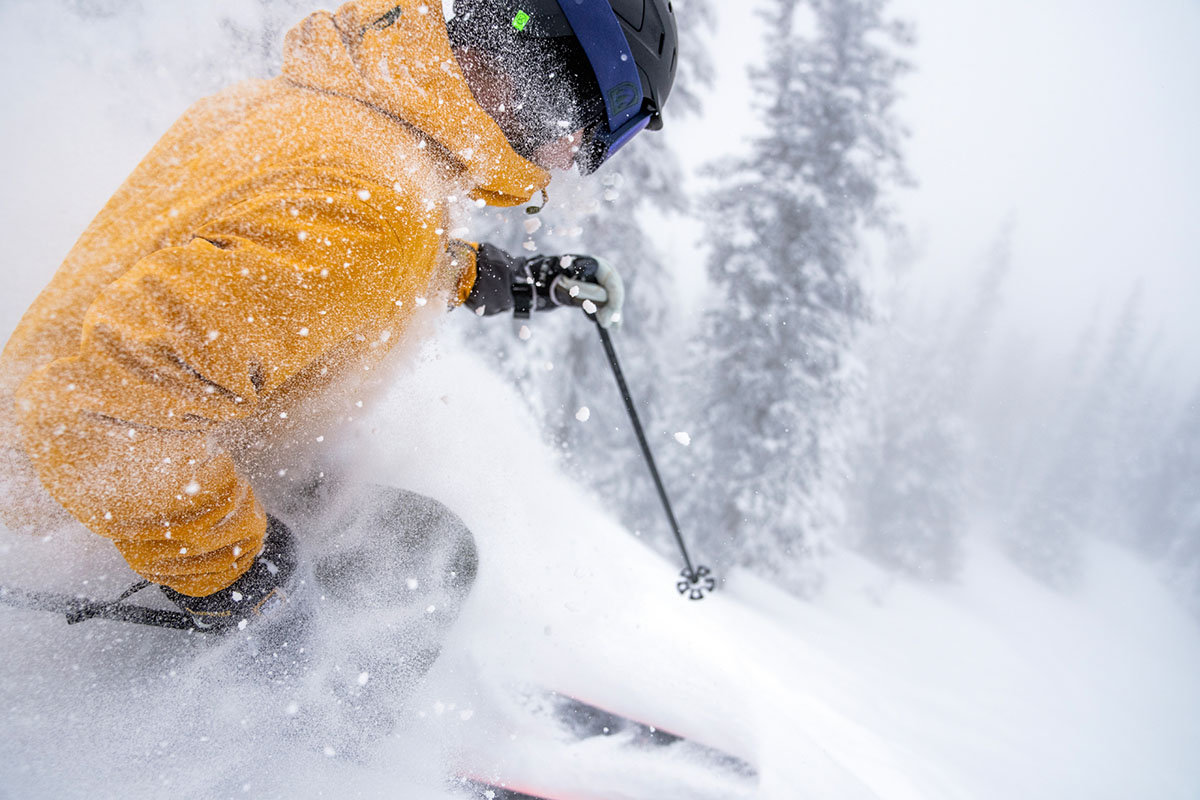
For those who prefer to earn their turns, Outdoor Research’s Skytour AscentShell Jacket is our favorite option for backcountry riders this season. As its name suggests, the Skytour utilizes OR’s in-house AscentShell membrane that offers excellent protection alongside impressive breathability. The Skytour is also competitively light (1 lb. 6.1 oz.) without compromising much in the way of features, including pit zips, a helmet-compatible hood, water-resistant exterior zippers, and a practical six-pocket storage layout. You do lose out on a powder skirt and Recco reflector, and the shell fabric is a little thin for frequent inbounds use. In the end, we’d point dedicated resort riders to the more robust and feature-rich Cosmic, but the Skytour checks all the boxes for weight- and bulk-conscious backcountry skiers.
Another quality Outdoor Research design to consider is their Carbide Jacket, which is designed for mixed front- and backcountry use with a slant toward the latter. In this case, OR opted for a 3-layer Pertex Shield construction with fully taped seams for reliable protection in inclement weather. The Carbide is also impressively light at just 1 pound 5.5 ounces while retaining key features like multiple hood drawcords, pit zips, a powder skirt, and a generous seven pockets for stashing the essentials. However, OR did need to make some sacrifices to keep weight low, the biggest of which is durability: With a thin 40D shell fabric, the Carbide lacks the confidence-inspiring feel of the Cosmic and won’t stand up as well to frequent, long-term resort use. It’s perfectly serviceable for minimalist tours and the occasional inbounds outing, but committed resort riders will benefit from spending up for the Cosmic.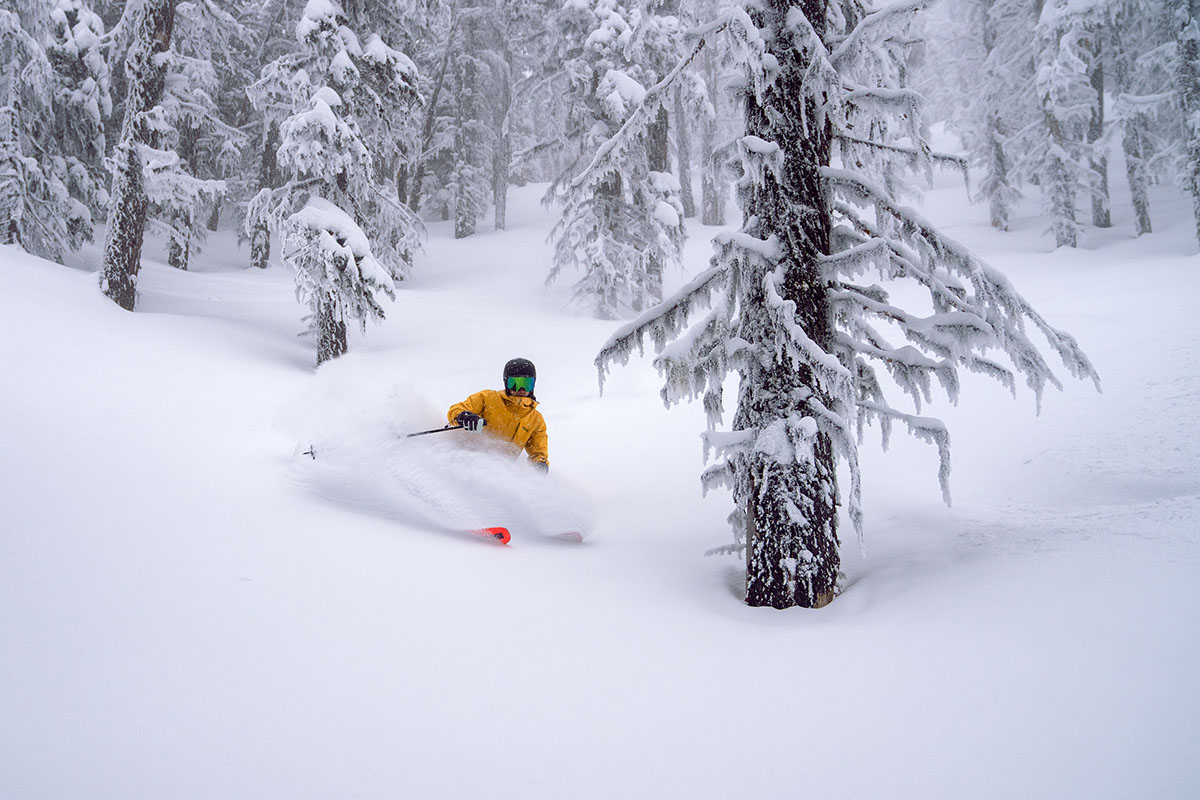
We’d be remiss not to cover Arc’teryx’s Sabre here, which is our top-rated ski jacket this season and one of the most premium designs on the market. While undeniably spendy at a whopping $750, the Sabre leaves little to be desired from a performance standpoint. The 3-layer Gore-Tex construction is extremely trustworthy in harsh conditions, the soft flannel backer provides great next-to-skin comfort, and fit and finish are up to Arc’teryx’s typical high standards. The Sabre also checks in lighter than the Cosmic at 1 pound 8.9 ounces. You do sacrifice the Trew’s dual exterior chest pockets, but the rest of the design stacks up impressively well. Again, the Cosmic gets the clear edge in value and organization, but the Sabre is unmatched in terms of overall quality and attention to detail (for more, check out our in-depth Sabre Jacket review).
A final alternative to consider is Patagonia’s Storm Shift Jacket. For the same price as the Cosmic, the Storm Shift boasts a high-quality and very durable 2-layer Gore-Tex build that performed flawlessly throughout testing. Comfort and durability are two other hallmarks: The Storm Shift boasts a tricot knit lining that’s smooth against the skin, along with an ultra-durable 150D shell fabric that’s remarkably hardwearing and confidence-inspiring around sharp gear. These additions do add bulk, however, and the Patagonia’s 2-layer build makes it even less appealing for occasional touring. In the end, a final decision will come down to your priorities: The Storm Shift is great for frequent resort-goers who are hard on their gear, while the Cosmic wins out in mobility and storage (without compromising too heavily on all-out toughness).
Editor’s note: We usually provide a live price comparison table below our outdoor gear reviews, but the latest Cosmic is currently only available directly through Trew Gear (the past-generation model is available elsewhere). You can see the Cosmic Primo Jacket page here and support us in the process. Thanks!